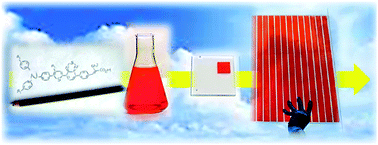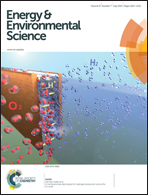Metal-free organic sensitizers with narrow absorption in the visible for solar cells exceeding 10% efficiency†
Abstract
A novel family of six donor–acceptor type organic sensitizers for dye-sensitized solar cells (DSSCs) is reported. The dyes have been designed to have outstanding light absorption properties in the visible range and being able to achieve high photon-to-electrical current conversion for BIPV (building-integrated photovoltaic). Moreover, stability tests under illumination at 1 Sun and 65 °C showed a great stability for some of the devices, with less than 6% decrease of power conversion efficiency after 3000 hours. The differences in the performance of the six sensitizers under standard illumination conditions can be correlated with the observed differences in the photo-induced transient photovoltage and in charge extraction measurements. We report the use of one of the dyes for the fabrication of semi-transparent solar modules showing an active area of 1400 cm2 and a power output of 10.5 W m−2.


 Please wait while we load your content...
Please wait while we load your content...